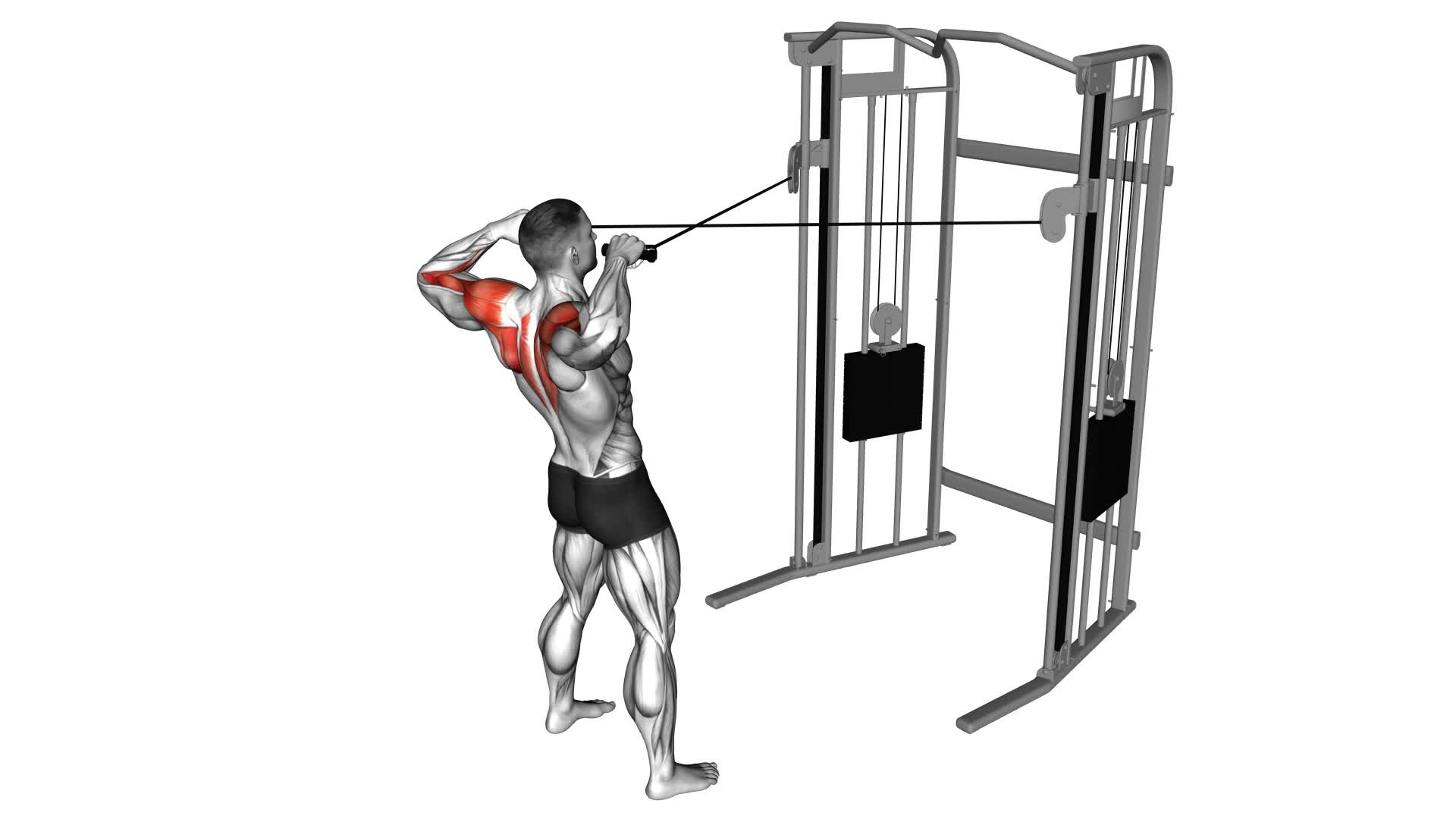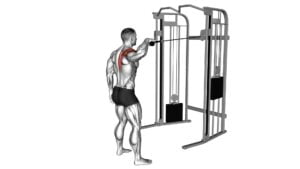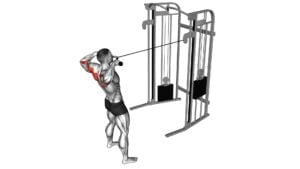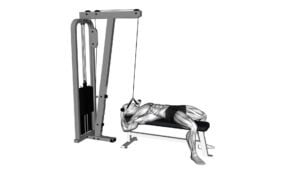Cable Standing Face Pull – Video Exercise Guide & Tips

Are you looking for a new exercise to target your upper back and shoulders? Look no further than the cable standing face pull!
Watch This Exercise Video
In this video exercise guide, we'll show you the proper form and technique for this effective move.
Plus, we'll provide tips and variations to help you get the most out of your workout.
Get ready to strengthen and sculpt your upper body with the cable standing face pull!
Key Takeaways
- Cable standing face pulls target muscles in the shoulders and upper back
- Proper form and technique are crucial for maximizing effectiveness and preventing injuries
- Incorporating face pulls into a routine leads to improved posture, shoulder stability, and upper body strength
- Variations and progressions can be incorporated to increase the challenge and target different muscle groups.
Benefits of Cable Standing Face Pulls
To maximize your shoulder and upper back strength and stability, incorporating cable standing face pulls into your workout routine can be highly beneficial. Cable standing face pull variations are excellent exercises for targeting the muscles in your shoulders and upper back, helping to improve your overall posture and upper body strength.
One of the main benefits of cable standing face pulls is that they allow you to work your shoulder muscles from different angles and intensities. By adjusting the height of the cable machine and the grip you use, you can target specific areas of your shoulders and upper back, helping to develop a well-rounded and balanced physique.
Additionally, cable standing face pulls are great shoulder mobility exercises. As you pull the cable towards your face, you're actively engaging your shoulder muscles, promoting increased range of motion and flexibility in your joints. This can be especially beneficial for individuals who perform a lot of overhead movements or have tight shoulder muscles.
Proper Form and Technique for Cable Standing Face Pulls
To perform cable standing face pulls with proper form and technique, there are several key points to keep in mind.
First, focus on shoulder activation cues, such as retracting your scapulae and pulling the cable towards your face at eye level.
Second, be aware of common mistakes to avoid, such as using excessive momentum or shrugging your shoulders.
Shoulder Activation Cues
Start by gripping the cable attachment with both hands and standing with your feet shoulder-width apart. To ensure proper shoulder activation during cable standing face pulls, follow these cues:
- Engage your core: Before starting the exercise, brace your core by drawing your belly button in towards your spine. This will help stabilize your body and maintain proper form throughout the movement.
- Squeeze your shoulder blades: As you pull the cable towards your face, focus on squeezing your shoulder blades together. This will help activate the muscles in your upper back and improve your posture.
- Control the movement: Slowly pull the cable towards your face while keeping your elbows high and wide. Avoid using momentum or jerking motions, and maintain control throughout the exercise.
By incorporating these shoulder activation cues and performing regular shoulder mobility drills, you can improve your form and technique during cable standing face pulls.
Transitioning into the subsequent section about common mistakes to avoid, it's important to be aware of these errors to maximize the effectiveness of your workout.
Common Mistakes to Avoid
Avoid these common mistakes to ensure proper form and technique for cable standing face pulls. Improper form can lead to injuries and hinder your progress.
One common mistake to avoid is using excessive weight. It's important to start with a lighter weight and focus on proper form before increasing the resistance.
Another mistake is pulling the cable too far back, which can strain your shoulders and neck. Instead, aim to bring the handles towards your forehead, focusing on engaging your rear delts and upper back muscles.
Additionally, avoid using momentum to complete the exercise. Keep the movement controlled and deliberate.
If you find that cable standing face pulls are still challenging, there are alternative exercises such as band pull-aparts or bent-over dumbbell rows that can target the same muscle groups.
Benefits of Face Pulls
To maximize the benefits of cable standing face pulls, focus on maintaining proper form and technique. Here are three key benefits of incorporating this exercise into your routine:
- Improved Posture: Cable standing face pulls target the muscles in your upper back, specifically the rear deltoids and rhomboids. Strengthening these muscles can help improve your posture by pulling your shoulders back and countering the effects of hunching over a desk or computer.
- Shoulder Stability: The pulling motion of cable standing face pulls activates the muscles that stabilize your shoulders, such as the rotator cuff. Strengthening these muscles can help prevent shoulder injuries and improve overall shoulder stability.
- Upper Body Strength: This exercise engages multiple muscle groups in your upper body, including your back, shoulders, and arms. By regularly performing cable standing face pulls with proper technique, you can develop strength and muscular endurance in these areas, leading to a stronger upper body overall.
Incorporating cable standing face pulls into your workout routine can yield significant benefits for your posture, shoulder stability, and upper body strength. Remember to maintain proper form and technique to maximize the effectiveness of this exercise.
Equipment and Setup for Cable Standing Face Pulls
To properly set up for cable standing face pulls, follow these steps:
- Adjust the cable height to chest level.
- Grasp the handles with an overhand grip, ensuring that your hands are shoulder-width apart.
- Stand with your feet shoulder-width apart.
- Keep a slight bend in your knees and maintain a neutral spine position throughout the exercise.
Cable Height Adjustment
Adjust the cable height for your cable standing face pulls to ensure proper equipment setup and form execution. Here are three important things to consider when adjusting the cable height:
- Start by setting the cable at a height that allows you to comfortably grasp the handles with your arms fully extended. This will ensure that you have enough resistance to effectively engage your back muscles throughout the exercise.
- Stand facing the cable machine, with your feet shoulder-width apart and knees slightly bent. This stable body positioning will provide a solid foundation for performing the face pulls and prevent any unnecessary strain on your lower back.
- Adjust the height of the cable so that it aligns with your face or slightly higher. This will allow you to pull the handles towards your forehead, targeting your upper back and shoulder muscles effectively.
Proper Grip Technique
When setting up the equipment for cable standing face pulls, it's important to ensure a proper grip technique for optimal results.
The correct hand placement is crucial for targeting the desired muscles and preventing any unnecessary strain. To begin, grab the handles of the cable machine with an overhand grip, making sure your palms are facing downward. Position your hands slightly wider than shoulder-width apart, allowing for a comfortable grip.
As you perform the exercise, focus on maintaining a firm grip without overly tensing your forearms. This will help you maintain control and stability throughout the movement. By having the correct hand placement, you can effectively engage your back muscles and avoid any potential injuries.
Now, let's move on to discussing the proper stance and body positioning for cable standing face pulls.
Stance and Body Positioning
Stand with your feet shoulder-width apart and facing the cable machine. This stance will provide a stable base and allow for proper body alignment during the cable standing face pull exercise. It's important to maintain good posture throughout the movement to maximize muscle activation and prevent injury.
To ensure proper body alignment, follow these tips:
- Keep your core engaged and your spine neutral. Avoid arching your back or rounding your shoulders.
- Stand tall with your chest lifted and shoulder blades pulled back and down.
- Maintain a slight bend in your knees to prevent locking them out.
Variations and Progressions for Cable Standing Face Pulls
To enhance your cable standing face pulls, try incorporating various modifications and advancements.
There are several variations and progressions that can help target different muscle groups and increase the difficulty of the exercise.
One variation is the single-arm cable face pull, where you perform the exercise using only one arm at a time. This variation helps improve unilateral strength and stability.
Another variation is the kneeling cable face pull, where you perform the exercise while kneeling on the ground. This variation places more emphasis on the core and lower body stability.
To progress the cable standing face pull, you can increase the weight or resistance of the cable machine. This will challenge your muscles even more and help build strength and size.
Another progression is to perform the exercise on an unstable surface, such as a stability ball or balance board. This will engage your stabilizer muscles and improve overall balance and coordination.
Remember to always maintain proper form and technique when performing variations and progressions. Start with lighter weights and gradually increase the difficulty as you become more comfortable and stronger.
Incorporating these modifications and advancements into your cable standing face pull routine will help you continue to challenge your muscles and achieve your fitness goals.
Common Mistakes to Avoid During Cable Standing Face Pulls
To avoid common mistakes during cable standing face pulls, make sure to maintain proper form and technique throughout the exercise. Here are three important tips to keep in mind:
- Proper Breathing: It's crucial to focus on your breathing during cable standing face pulls. Inhale before pulling the cable towards your face, and exhale as you return to the starting position. This helps stabilize your core and ensures you're engaging the correct muscles throughout the movement.
- Recommended Weight: Selecting the appropriate weight is key to performing cable standing face pulls correctly. Start with a lighter weight and gradually increase as you gain strength and confidence. Using too heavy of a weight can lead to improper form and increase the risk of injury.
- Maintain Control: One common mistake is using momentum to pull the cable towards your face. Remember, the goal is to target the muscles in your upper back and shoulders, so focus on maintaining control throughout the entire movement. Slowly pull the cable towards your face and squeeze your shoulder blades together at the end of the movement before returning to the starting position.
By following these tips, you can ensure that you're performing cable standing face pulls correctly and effectively.
Now, let's move on to the next section to learn some tips for getting the most out of this exercise.
Tips for Getting the Most Out of Cable Standing Face Pulls
To maximize the effectiveness of cable standing face pulls, incorporate a variety of grip positions throughout your workout. By changing your grip, you can target different muscles in your shoulders and upper back, leading to improved shoulder mobility and overall strength.
Start by using a pronated grip, with your palms facing down. This targets the rear delts and upper back muscles.
Next, switch to a supinated grip, with your palms facing up. This variation places more emphasis on the biceps and lower traps.
Finally, try a neutral grip, where your palms face each other. This engages the muscles in the middle and lower parts of your back.
Incorporating face pulls into a full body workout is an effective way to strengthen your shoulders while also engaging other muscle groups. For example, you can pair face pulls with exercises like squats or lunges to work your lower body, or with push-ups or bench presses to target your chest and triceps. This allows you to maximize your time at the gym and achieve a well-rounded workout.
Remember to maintain proper form throughout the exercise. Stand with your feet shoulder-width apart, knees slightly bent, and core engaged. Keep your back straight and pull the cable towards your face, leading with your elbows. Squeeze your shoulder blades together at the end of the movement, then slowly release and repeat.
Frequently Asked Questions
Can Cable Standing Face Pulls Help Improve Posture?
Yes, cable standing face pulls can definitely help improve your posture.
By performing this exercise correctly, you can experience several benefits such as strengthening your upper back muscles and improving shoulder stability.
Proper form is crucial when doing cable standing face pulls to ensure that you're engaging the right muscles and avoiding any potential injuries.
How Often Should Cable Standing Face Pulls Be Incorporated Into a Workout Routine?
To maximize the benefits of cable standing face pulls and incorporate them into your workout routine, it's important to consider frequency.
The frequency of incorporating cable standing face pulls will depend on your fitness goals and current training program. Generally, it's recommended to perform this exercise 2-3 times per week.
However, variations of cable standing face pulls can be used to target different muscles and add variety to your routine.
Remember to always listen to your body and adjust the frequency as needed.
Are There Any Modifications for Individuals With Shoulder Injuries or Limitations?
If you have shoulder injuries or limitations, there are modifications you can make to the cable standing face pull exercise. It's important to prioritize shoulder rehab exercises to prevent further damage.
Instead of doing cable standing face pulls, you can try alternative exercises that put less strain on the shoulders, such as resistance band pull-aparts or dumbbell rear delt flies.
These exercises can help strengthen the rear delts and upper back while minimizing stress on the shoulders.
Can Cable Standing Face Pulls Be Done With Different Grip Variations?
Yes, cable standing face pulls can be done with different grip variations.
By changing your hand positions, you can target different muscles in your upper back and shoulders.
Using an overhand grip will primarily work your rear delts, while an underhand grip will engage your biceps more.
Additionally, using a neutral grip will activate your traps and rhomboids.
These variations allow for a well-rounded upper body workout and help improve posture and shoulder stability.
What Muscles Are Targeted During Cable Standing Face Pulls?
During cable standing face pulls, multiple muscles are targeted, including the rear delts, traps, and upper back. These exercises help to improve your posture, shoulder stability, and upper body strength.
By performing cable standing face pulls, you can effectively engage and strengthen these muscles, leading to better overall shoulder health and enhanced athletic performance.
Incorporating this exercise into your routine can provide numerous benefits, such as improved posture and reduced risk of shoulder injuries.
Conclusion
In conclusion, cable standing face pulls are an effective exercise for targeting the muscles in your upper back and shoulders. By using proper form and technique, you can improve your posture, strengthen your muscles, and prevent injuries.
Remember to start with a light weight and gradually increase the resistance as you become stronger. Avoid common mistakes such as using momentum or letting the shoulders shrug up.
By following these tips, you can maximize the benefits of cable standing face pulls and achieve your fitness goals.

Author
Years ago, the spark of my life’s passion ignited in my mind the moment I stepped into the local gym for the first time. The inaugural bead of perspiration, the initial endeavor, the very first surge of endorphins, and a sense of pride that washed over me post-workout marked the beginning of my deep-seated interest in strength sports, fitness, and sports nutrition. This very curiosity blossomed rapidly into a profound fascination, propelling me to earn a Master’s degree in Physical Education from the Academy of Physical Education in Krakow, followed by a Sports Manager diploma from the Jagiellonian University. My journey of growth led me to gain more specialized qualifications, such as being a certified personal trainer with a focus on sports dietetics, a lifeguard, and an instructor for wellness and corrective gymnastics. Theoretical knowledge paired seamlessly with practical experience, reinforcing my belief that the transformation of individuals under my guidance was also a reflection of my personal growth. This belief holds true even today. Each day, I strive to push the boundaries and explore new realms. These realms gently elevate me to greater heights. The unique combination of passion for my field and the continuous quest for growth fuels my drive to break new ground.







